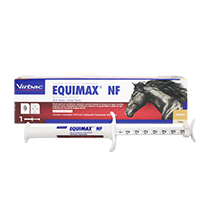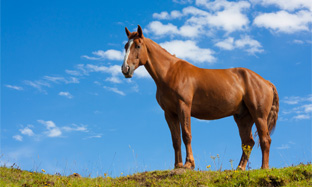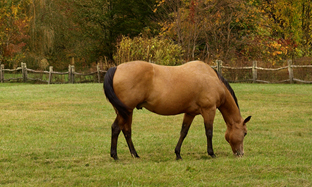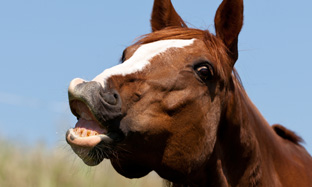
Dewormer
Equimax™ NF
Broadspectrum roundworm, tapeworm and bot remedy for horses of all ages, including pregnant mares
FOR ANIMAL USE ONLY
CAUTION
COMPOSITION
Ivermectin 1,87 % m/m
Praziquantel 14,03 % m/m
DIRECTIONS FOR USE - Use only as directed
Equimax is administered orally by means of a disposable syringe at a dose rate of 200 μg of ivermectin and 1,5 mg of praziquantel per kg of body mass (1,07 g of oral paste per 100 kg body weight). Each mass marking on the syringe plunger delivers enought paste to treat 100 kg body mass.
|
Weight |
Dosage |
Weight |
Dosage |
|
Up to 100 kg |
1,070 g |
401 - 450 kg |
4,815 g |
|
101 - 150 kg |
1, 605 g |
451 - 500 kg |
5,350 g |
|
151 - 200 kg |
2,140 g |
501 - 550 kg |
5,885 g |
|
201 - 250 kg |
2,675 g |
551 - 600 kg |
6,420 g |
|
251 - 300 kg |
3,210 g |
601 - 650 kg |
6,955 g |
|
301 - 350 kg |
3,745 g |
651 - 700 kg |
7,490 g |
|
351 - 400 kg |
4,280 g |
EFFICACY:
EQUIMAX broad spectrum parasiticide for horses provides effective control for all major worms of horses including:
|
Large strongyles |
|
|
Strongylus vulgaris (adult and arterial larvae) - bloodworm |
|
|
Strongylus edentatus (adult and encisted larvae / tissue stage) |
|
|
Strongylus equinus (adult) |
|
|
Triodontophorus (adult) |
|
|
Small Strongyles: |
|
|
Cyathostomum spp. (adults and 4th stage larvae) |
|
|
Cylicocyclus spp. (adults and 4th stage larvae) |
|
|
Cylicostephanus spp. (adults and 4th stage larvae) |
|
|
Cylicodontophorus spp. (adults and 4th stage larvae) |
|
|
Gyalocephalus spp. (adults and 4th stage larvae) |
|
|
Ascarids: |
|
|
Parascaris equorum (adults and 3rd and 4th stage larvae) |
|
|
Pinworm: |
|
|
Oxyuris equi (adults and 3rd and 4th stage larvae) |
|
|
Hairworm: |
|
|
Trichostrongylus axei (adults) |
|
|
Intestinal threadworms: |
|
|
Strongyloides westeri (adults) |
|
|
Large-mouthed stomach worms: |
|
|
Habronema muscae (adults) |
|
|
Draschia spp. (3rd stage larvae) |
|
|
Lungworms: |
|
|
Dictyocaulus amfieldi (adults and 4th stage larvae) |
|
|
Cestodes |
|
|
Anoplocephala spp. |
|
|
Bots |
|
|
Gasterophilus spp. (oral and gastric stages) |
Equimax is also effective for the control of skin lesions caused by Habronema spp. and Draschia spp. cutaneous larvae (summer sores) and Onchocerca spp. microfilariae (cutaneous onchocerciasis).
ADMINISTRATION:
Insert the syringe in the gap between the front and back teeth and deliver paste onto the back of the tongue.
Immediately raise the horse’s head for a few seconds after dosing to ensure swallowing of the paste. Before administration, ensure that the horse does not have food in its mouth. The body mass of the horse should be determined accurately to maximise the use of the paste.
Suggested Worm Control Programme
All horses should be included in a regular worm control programme.
Mares: Regular dosing at 6 - 8 week intervals on pastures during summer and autumn is recommended.
Stallions: Treat at least twice a year.
Foals: Regular strategic treatment at 6 - 8 week intervals, commencing at approximately two months of age, is recommended.
Bots: Bot fly activity increases in the late spring and usually peaks in the autumn with a consequent accumulation of stomach bots carried in the winter. Treatment against bots attached to the stomach wall is essential to remove established burdens in the autumn and winter.
Consult your veterinarian for a worm control programme.
Horses of all ages, including pregnant mares, breeding stallions and foals can be treated with no adverse effects.
WARNINGS:
- Do not use in animals intended for human consumption.
- All pregnant mares must be treated with the usual additional care.
- Keep out of reach of children, uninformed persons and animals.
- Although this remedy has been extensively tested under a large variety of conditions, failure thereof may ensue as a result of a wide range of reasons. If this is suspected, seek veterinary advice and notify the registration holder.
PRECAUTIONS:
- Store in a safe place.
- Refrain from smoking and eating whilst handling the product.
- Wash hands after use.
PRESENTATION:
Disposable syringe containing 7,49 g paste.
STORAGE INSTRUCTIONS:
Store in a cool dry place.
REGISTRATION HOLDER:
VIRBAC RSA (Pty) Ltd
(Reg No. 1990/003743/07)
Private Bag X115
Halfway House
1685
South Africa
Tel: +27 12 657 6000
REGISTRATION NUMBERS:
South africa Reg. No. G3546 (Act 36/1947)
Zambia Reg. No: 359/742 V
- Can I use EQUIMAX in my stallion?
EQUIMAX can be safely used in breeding stallions at any time without adversely affecting their fertility.
- Can I use EQUIMAX in pregnant mares?
Yes EQUIMAX can be used in mares at all stages of pregnancy. Pregnant mares should be treated as normal during their pregnancy taking care not to stress them during treatment. Mares should be wormed two weeks prior to their expected foaling date. Once a mare has foaled, the mare and foal should both be wormed with first foal worming at twelve weeks of age and subsequently every eight weeks so that large burdens are not allowed to develop.
- Can I use EQUIMAX on an animal other than a horse?
EQUIMAX is registered for use in horses which means it may be safely used in horses. The use of this product in any other species would be considered “off label use”. Products should not be used outside of their registered label claims without first consulting a veterinarian (if at all). Variation in metabolisms between different species mean that dose rates can vary quite widely and that some species may be far more sensitive than others making products dangerous or even potentially fatal to those animals. It is for this reason that “off label use" should only be conducted under the supervision of a veterinarian.
- How often should I worm my horse?
Autumn and spring will always be key times to worm all horses. Worm all adult horses once in Spring with STRATEGY-T® and once in Autumn with EQUIMAX® or EQUIMAX® ELEVATION. It makes sense to target mectin wormers in the cooler months when bots and small stronglyes are more active inside the horse. Using non-mectin chemicals is typically suited to the warmer months although if summer sores are a problem a mectin product will be needed.
Worming strategically involves worming your horse based on the parasite lifecycle, risk of disease and likely resistance status of worms. In Australia, seasonal conditions are ideal for parasite growth during most of the year, particularly the warm, wet months of spring and autumn, however, the lifecycle of different parasites mean that they may be more active at different times of the year. When considering a worming program, you must also ensure that you include faecal egg count testing.
- Why is it important for me to accurately estimate my horses weight?
Most people underestimate their horse’s weight by as much as 20%. Underestimating a horse’s weight can lead to underdosing. Giving a horse less than the required dose of wormer can leave them at risk of worm-related disease as potentially worms will be left untreated within the horse. Underdosing can also encourage the development of resistance in your horses by exposing the worms to sub-lethal doses of wormer. It is therefore vitally important to correctly estimate your horses’ weight when deciding on the correct dose of wormer to give them. It is in fact preferable to give horses a slight overdose rather than an underdose. There are several methods for finding out a horse’s weight, the most accurate obviously being a set of scales. As most horse owners to not have easy access to horse scales, there are several other methods that horse owners can use to get a good estimate of their horses’ weight. The use of the weight estimation formula will give a reasonably good estimation of most horses’ weight. The formula is:
![horse weight formula]()
Another method that can be used to estimate weight is by using one of the commercially available weight tapes. Unfortunately, some of these tapes are far more accurate than others so it is a good idea to calibrate the tape using the formula first to check that it is measuring accurately. Weight tapes are also not suitable to use in immature horses as they have a different body composition to older animals.
- What is Gold Standard worming and why should I be doing it?
Virbac is leading the way in strategic worming programs for horses based on the parasite lifecycle, risk of disease and likely resistance status of worms. Our Gold Standard program combines trusted solutions from Virbac and our unique ‘3D’ best management practices to deliver premium and sustainable worm control. Gold standard ensures best long-term protection for the available drugs and most importantly your horse.
- When should I start worming my foal?
Once a mare has foaled the mare and foal should both be wormed with the first foal worming recommended at twelve weeks of age. Young horses need to be treated differently to older horses because they are at risk of mectin resistant ascarids. Ascarids appear to be the worm developing resistance to mectins. Generally ascarids are not found in horses over two years of age as horses seem to develop a natural immunity to these worms as they mature. To protect young horses from potential mectin resistance, it is recommended that a combination product registered to treat mectin resistant ascarids, such as EQUIMAX® ELEVATION or STRATEGY-T®, be used. Young horses should be wormed with STRATEGY-T in spring and summer and EQUIMAX ELEVATION in autumn and winter until they are two years old. Faecal egg count (FEC) testing is recommended once they become a yearling to understand their parasite burden and then worm based on results.





